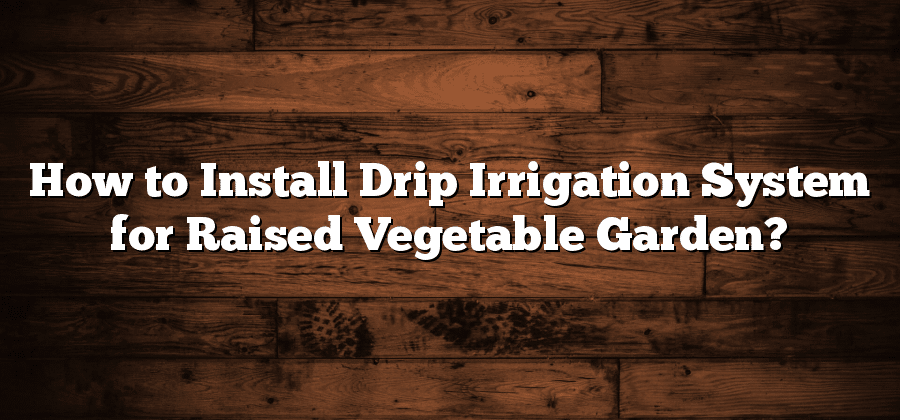Benefits of Drip Irrigation Systems for Raised Vegetable Gardens
Drip irrigation systems offer numerous benefits for raised vegetable gardens. One of the key advantages is water efficiency. Unlike traditional watering methods, such as sprinklers or hand watering, drip irrigation delivers water directly to the roots of the plants. This targeted approach minimizes water wastage through evaporation or runoff, ensuring that the plants receive the precise amount of moisture they need. As a result, not only do drip irrigation systems conserve water, but they also promote healthier plant growth by eliminating the risk of over or under-watering.
In addition to water efficiency, drip irrigation systems also help to reduce weed growth in raised vegetable gardens. By delivering water specifically to the plants, rather than the entire garden bed, drip irrigation restricts the opportunity for weed seeds to germinate and thrive. This means less time and effort spent on manual weeding, allowing gardeners to focus on more enjoyable aspects of gardening, such as harvesting the bountiful vegetables cultivated in their raised beds. Overall, the benefits of drip irrigation systems for raised vegetable gardens are plentiful, making it a worthwhile investment for any garden enthusiast.
Assessing Your Garden’s Watering Needs
When it comes to assessing your garden’s watering needs, it is crucial to consider factors such as climate, soil type, and the specific types of vegetables you are growing. Understanding these elements will help you determine the appropriate amount of water your plants require and the frequency at which they need to be watered.
First and foremost, you need to consider the climate in which your garden is located. Different regions have different weather patterns and rainfall levels, which directly impact your watering needs. In arid or hot climates, for example, you may need to water your plants more frequently to ensure they receive enough moisture to thrive. On the other hand, if you live in a region with ample rainfall, you may only need to supplement that with occasional watering during dry spells. By assessing your garden’s climate, you can tailor your watering schedule accordingly.
Selecting the Right Drip Irrigation Components
When it comes to selecting the right drip irrigation components for your raised vegetable garden, there are a few key factors to consider. Firstly, you need to assess the specific needs of your garden. Determine the size of your garden beds, the types of vegetables you are growing, and the overall layout of your space. These factors will help you determine the appropriate type and quantity of components you will need.
Secondly, it is important to choose high-quality components that are durable and reliable. Look for components that are made from UV-resistant materials, as they will be exposed to direct sunlight for extended periods of time. Additionally, consider the water pressure in your area and choose components that are compatible with the pressure levels. This will ensure that your drip irrigation system functions efficiently and effectively.
Lastly, consider the design and layout of your drip irrigation system. Select components that are compatible with your chosen system design, such as drip emitters, tubing, fittings, and filters. Take into account the water flow requirements of each plant and ensure that the components you choose will provide adequate water distribution throughout your garden.
By carefully selecting the right drip irrigation components, you can ensure the success of your raised vegetable garden. So, take the time to assess your garden’s needs, choose the appropriate components, and design a drip irrigation system that will keep your plants thriving and healthy.
Preparing Your Raised Garden Bed for Installation
When it comes to preparing your raised garden bed for installation of a drip irrigation system, there are a few key steps to follow. Firstly, ensure that the bed is well-prepared and free from any weeds or debris. Clear the bed of any existing plants or vegetation, as they may interfere or obstruct the installation process. Additionally, it is important to level the bed to create an even surface. This will help to ensure that the water distribution through the drip irrigation system is consistent and efficient.
Next, consider the type of soil in your raised garden bed. Depending on the composition and drainage capacity of your soil, you may need to make some amendments to optimize the performance of the drip irrigation system. Adding organic matter such as compost or peat moss can help improve the overall water retention and drainage qualities of the soil. It is also beneficial to check and adjust the pH level of the soil, as certain plants may require a specific pH range for optimal growth. Taking the time to prepare your raised garden bed before installing the drip irrigation system will greatly contribute to the success and effectiveness of your vegetable garden.
Laying Out the Drip Irrigation System Design
Once you have selected the components for your drip irrigation system and prepared your raised garden bed, it is time to lay out the design for your system. This step is crucial to ensure that every plant in your garden receives the necessary amount of water.
Begin by measuring the dimensions of your garden bed and marking them on a piece of graph paper. This will serve as your reference as you plan the placement of the drip irrigation lines. Consider the spacing requirements of your plants and the water requirements of each individual plant. You may want to create separate zones within your garden bed, especially if you have plants with different water needs. Once you have a rough idea of where the lines should be placed, use stakes or flags to mark the location. This will give you a visual representation of how the system will be laid out and allow you to make any necessary adjustments before installation.






